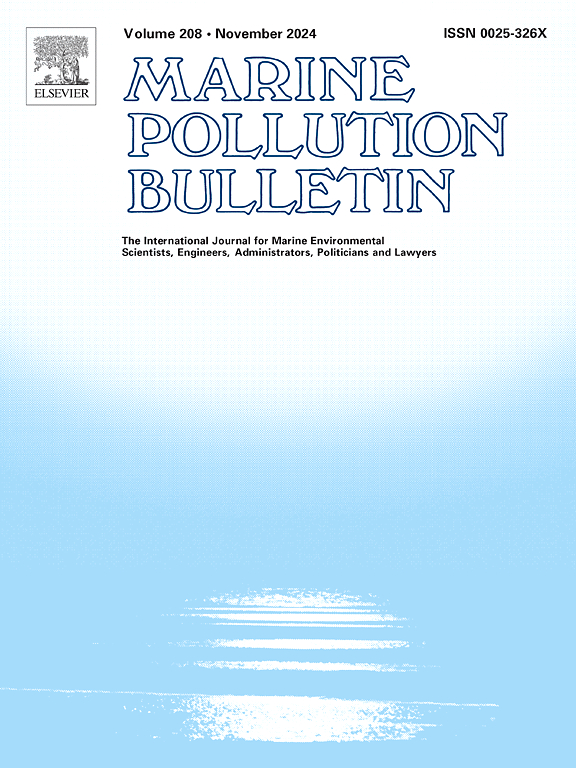Spatial distribution of the summer chlorophyll a and nutrients in the Pearl River Estuary
IF 4.9
3区 环境科学与生态学
Q1 ENVIRONMENTAL SCIENCES
引用次数: 0
Abstract
Estuaries, critical land-sea interfaces, mediate terrestrial inputs and sustain coastal ecosystems, with high ecological and economic significance. The Pearl River Estuary (PRE), the largest estuary in southern China and a core of the high-density Guangdong-Hong Kong-Macau Greater Bay Area, connects the Pearl River to the South China Sea, experiencing complex runoff, intense anthropogenic activities, and sensitive ecosystems. Eutrophication has emerged with rapid regional development. Based on field surveys conducted in the PRE and adjacent waters during summer 2023, this study employed a three-end-member mixing model to analyze the distribution of chlorophyll-a (Chl-a) and nutrients, as well as their regulatory mechanisms controlled by environmental factors. Results showed that high Chl-a zones were concentrated in the salinity transition zone, whose formation was synergistically regulated by factors such as salinity, light availability, and nutrient inputs. Although nutrient concentrations were high within the estuary, Chl-a levels remained relatively low due to light limitation caused by suspended particulate matter. The study area exhibited a nitrogen-rich and phosphorus-limited pattern. Notably, in the estuary and near-mouth regions, where significant changes in Chl-a concentration occurred, a moderate negative correlation (r = −0.456, p < 0.05) was identified between Chl-a and PO₄-P. The three-end-member mixing model confirmed that salinity-driven mixing served as the primary driver of nutrient distribution in the PRE. Model results showed that nutrient processes within the estuary were dominated by additive mechanisms, while consumptive processes prevailed outside the estuary mouth. These findings provide key insights into biogeochemical dynamics and eutrophication management in estuaries.
珠江口夏季叶绿素a及养分的空间分布
河口是重要的陆海界面,调节陆地输入并维持沿海生态系统,具有高度的生态和经济意义。珠江口(PRE)是中国南方最大的河口,是高密度粤港澳大湾区的核心,连接着珠江和南海,经历了复杂的径流、强烈的人为活动和敏感的生态系统。富营养化是随着区域快速发展而出现的。基于2023年夏季在PRE及邻近海域的野外调查,采用三端元混合模型分析了环境因子对叶绿素-a (Chl-a)和营养物质的分布及其调控机制。结果表明,高Chl-a区集中在盐度过渡区,其形成受盐度、光效度和养分投入等因素的协同调节。虽然河口内的营养物浓度较高,但由于悬浮颗粒物造成的光照限制,Chl-a水平相对较低。研究区呈现富氮限磷格局。值得注意的是,在Chl-a浓度变化显著的河口和近河口地区,Chl-a浓度呈中等负相关(r = - 0.456, p <;Chl-a与PO₄-P之间存在显著性差异(0.05)。三端元混合模型证实了盐度驱动混合是PRE中养分分布的主要驱动因素。模型结果表明,河口内的营养过程以加性机制为主,而河口外的营养过程以消耗机制为主。这些发现为河口生物地球化学动力学和富营养化管理提供了重要见解。
本文章由计算机程序翻译,如有差异,请以英文原文为准。
求助全文
约1分钟内获得全文
求助全文
来源期刊

Marine pollution bulletin
环境科学-海洋与淡水生物学
CiteScore
10.20
自引率
15.50%
发文量
1077
审稿时长
68 days
期刊介绍:
Marine Pollution Bulletin is concerned with the rational use of maritime and marine resources in estuaries, the seas and oceans, as well as with documenting marine pollution and introducing new forms of measurement and analysis. A wide range of topics are discussed as news, comment, reviews and research reports, not only on effluent disposal and pollution control, but also on the management, economic aspects and protection of the marine environment in general.
 求助内容:
求助内容: 应助结果提醒方式:
应助结果提醒方式:


